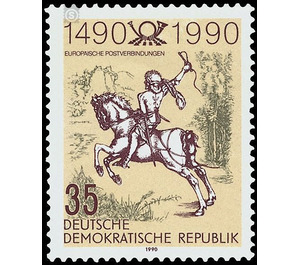Commemorative stamp series - Germany / German Democratic Republic 1990 - 35 Pfennig
| Country | Germany / German Democratic Republic |
| Issue Date | 1990 |
| Face Value | 35.00 |
| Color | brown |
| Perforation | K 13:13 1/2 |
| Printing Type | offset |
| Stamp Type | Postage stamp |
| Item Type | Stamp |
| Chronological Issue Number | 3041 |
| Chronological Chapter | GER-DDR |
| Michel ID | DDR 3299 |
| SID | 548458 |
| In 24 Wishlists | |
500 years of postal service Deutsche Post is celebrating the 500th anniversary of the organized postal system in Europe in 1990, just like the postal administrations of the Federal Republic of Germany, Belgium, Austria and Berlin (West). On the basis of the comments on the occasion of the said postal administrations for the 11./12. January 1990 provided special postage stamp issue also gives the Ministry for post office and telecommunications of the GDR a special postage stamp. The motif is identical to that of the other postal administrations. Special cancellation from January 12 to March 11, 1990 500 years of postal services The year 1990 is marked by the postal administrations of the German Democratic Republic, the Federal Republic of Germany, Belgium, Austria and Berlin (West), marking the 500th anniversary of a state-organized postal system. Three sources justify this anniversary: - An entry in the chronicle of the city of Memmingen, according to which in 1490 a postal route was set up "from the country Austria to the Netherlands", were used on the foot and rider. - A dated 14 July 1490 letter of King Maximilian I to the "ersern ours faithful and the Reich faithful Mayor and Rate of Speyer instead," in which the establishment of a post office to operate the postal route and the order of each one riding and one Footmen is urged. - Entries in the books of accounts of the Upper Austrian Chambers in Innsbruck, which show payments to a "Johannetten Daxen", the first postmaster from the Thurn and Taxis family, for whose messenger services A developed messenger system existed in parts of Europe but even before that time: the rapidly developing trade over ever greater distances and the growing bourgeoisie in the cities, the rapid development of the intellectual life, which is on The monasteries and, increasingly, the universities, and not least the rulers and the central authority in the Holy Roman Empire, increasingly demanded the exchange of news in the late Middle Ages, but essentially only to the operators they lacked the regularity and speed of sending messages from a sender to the consignee. The postal service set up in 1490 by a member of the taxis family (later Thurn und Taxis) of Bergamo, Italy, on behalf of Maximilian I marked the beginning of a new, higher-level organization of news transport. It is characterized in that letters are carried by several detaching footmen or riders. For this purpose, post offices had to be set up at fixed intervals in the courses, which had to ensure the use of the messengers and the immediate forwarding of the messages. The postal service set up in 1490 initially connected the court of King Maximilian I - later Emperor Maximilian 1 - with his hereditary lands in the north. From Innsbruck he passed the Fernpass Memmingen, Rheinhausen, Hunsrück, Eifel and Ardennes to Mechelen in today's Belgium , The distance was covered by riders in 51/2 days - in winter in 61/2 days. Considering the former road conditions that was a short time. The postal network established by the taxis was constantly expanded in the following years and gained great importance. This is supported by the numerous lines, the regularity of connections and the volume of transport services. The German Post of the GDR commits in 1990, as well as the aforementioned postal administrations, the 500th anniversary of the postal service. As a prelude, a special postage stamp will be issued by the Ministry of Posts and Telecommunications on January 12, 1990. It shows the engraving "Der kleine Postreiter" by Albrecht Dürer. This motif is identical to corresponding issues of the Federal Republic of Germany, Belgium, Austria and Berlin (West). The model for the postage stamp, the copperplate engraving by Albrecht Dürer, was created in 1496. The depiction of the riding messenger may therefore be regarded as the work of a contemporary and therefore largely true to the original in the time of the founding of the post. This idea has also significantly influenced the choice of subject.
| Condition | Name | In Stock | Price | Price + Shipping | Store | |
|---|---|---|---|---|---|---|
 | Unmounted Mint ** | Commemorative stamp series - Germany / German Democratic Republic 1990 - 35 Pfennig | 9 | US $0.381 | US $3.63 |  FILATELIELOKET (0) FILATELIELOKET (0)Shipping US $3.25 Minimum Order US $2.72 |


